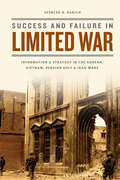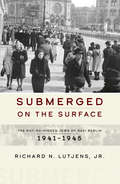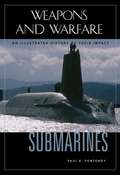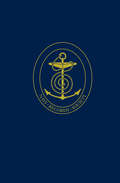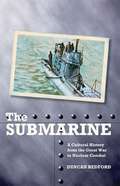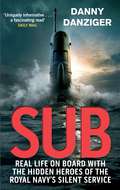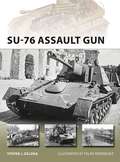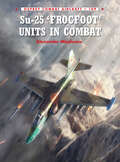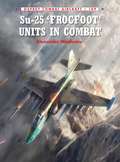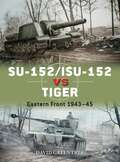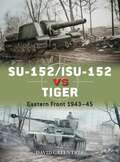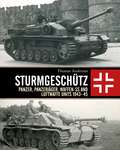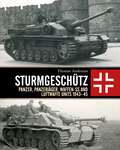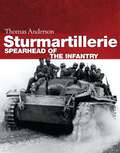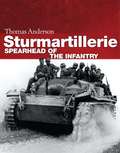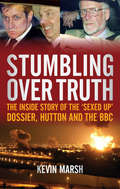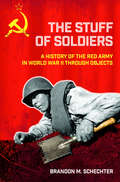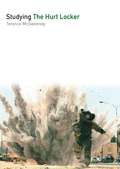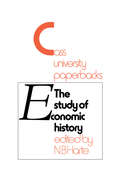- Table View
- List View
Success and Failure in Limited War: Information and Strategy in the Korean, Vietnam, Persian Gulf, and Iraq Wars
by Spencer D. BakichCommon and destructive, limited wars are significant international events that pose a number of challenges to the states involved beyond simple victory or defeat. Chief among these challenges is the risk of escalation—be it in the scale, scope, cost, or duration of the conflict. In this book, Spencer D. Bakich investigates a crucial and heretofore ignored factor in determining the nature and direction of limited war: information institutions. Traditional assessments of wartime strategy focus on the relationship between the military and civilians, but Bakich argues that we must take into account the information flow patterns among top policy makers and all national security organizations. By examining the fate of American military and diplomatic strategy in four limited wars, Bakich demonstrates how not only the availability and quality of information, but also the ways in which information is gathered, managed, analyzed, and used, shape a state’s ability to wield power effectively in dynamic and complex international systems. Utilizing a range of primary and secondary source materials, Success and Failure in Limited War makes a timely case for the power of information in war, with crucial implications for international relations theory and statecraft.
Success and Failure in Limited War: Information and Strategy in the Korean, Vietnam, Persian Gulf, and Iraq Wars
by Spencer D. BakichCommon and destructive, limited wars are significant international events that pose a number of challenges to the states involved beyond simple victory or defeat. Chief among these challenges is the risk of escalation—be it in the scale, scope, cost, or duration of the conflict. In this book, Spencer D. Bakich investigates a crucial and heretofore ignored factor in determining the nature and direction of limited war: information institutions. Traditional assessments of wartime strategy focus on the relationship between the military and civilians, but Bakich argues that we must take into account the information flow patterns among top policy makers and all national security organizations. By examining the fate of American military and diplomatic strategy in four limited wars, Bakich demonstrates how not only the availability and quality of information, but also the ways in which information is gathered, managed, analyzed, and used, shape a state’s ability to wield power effectively in dynamic and complex international systems. Utilizing a range of primary and secondary source materials, Success and Failure in Limited War makes a timely case for the power of information in war, with crucial implications for international relations theory and statecraft.
Submerged on the Surface: The Not-So-Hidden Jews of Nazi Berlin, 1941–1945
by Richard N. Lutjens Jr.Between 1941 and 1945, thousands of German Jews, in fear for their lives, made the choice to flee their impending deportations and live submerged in the shadows of the Nazi capital. Drawing on a wealth of archival evidence and interviews with survivors, this book reconstructs the daily lives of Jews who stayed in Berlin during the war years. Contrary to the received wisdom that “hidden” Jews stayed in attics and cellars and had minimal contact with the outside world, the author reveals a cohort of remarkable individuals who were constantly on the move and actively fought to ensure their own survival.
Submerged on the Surface: The Not-So-Hidden Jews of Nazi Berlin, 1941–1945
by Richard N. Lutjens Jr.Between 1941 and 1945, thousands of German Jews, in fear for their lives, made the choice to flee their impending deportations and live submerged in the shadows of the Nazi capital. Drawing on a wealth of archival evidence and interviews with survivors, this book reconstructs the daily lives of Jews who stayed in Berlin during the war years. Contrary to the received wisdom that “hidden” Jews stayed in attics and cellars and had minimal contact with the outside world, the author reveals a cohort of remarkable individuals who were constantly on the move and actively fought to ensure their own survival.
Submarines: An Illustrated History of Their Impact (Weapons and Warfare)
by Paul E. FontenoyFrom the steam-powered models introduced in World War I to today's nuclear-powered, multiweaponed technological wonders, submarines have revolutionized warfare on the world's seas. This volume follows the extraordinary development of this key component of the world's navies.Submarines: An Illustrated History of Their Impact reveals how underwater warships evolved to become major threats to battle fleets and merchant shipping, as well as primary platforms for deterrent forces and crucial symbols of military power.In a series of chronological chapters, Submarines describes key developments in diving ability, underwater endurance, and weapons capabilities in specific periods, while highlighting strategic and operational innovations; the role of technological research; famous submarine events, battles, and commanders; and the impact of submarine services on naval society. The book also includes an illustrated reference section covering every submarine class worldwide since 1900. This coverage plus additional reference features make Submarines an essential introduction to a weapons system that has long held the public's imagination.
The Submarine Service, 1900–1918
by Nicholas LambertThe year 2001 marks the centenary of the Royal Navy's submarine service. In the aftermath of the 2016 celebrations of the Battle of Jutland centenary, it is worth considering how the First World War at sea changed. This volume opens with an examination of the background to the Board of Admiralty's decision in 1900 to buy submarines, bringing to light documents that go a long way toward dispelling the myth that Britain's pre-1914 naval leaders were opposed to the development of the submarine as a major weapon. Indeed, the documents show that senior naval officers and influential civilians in Whitehall believed that the advent of the submarine would revolutionize naval warfare in a way that would bolster the Royal Navy's position as the world's predominant naval power. This edited selection of documents illustrates not only the Admiralty's thinking on the employment of the submarine between 1900 and 1918, it also charts the technical development of British submarines, and explains issues such as why the pioneer submariners came to regard themselves as an élite group within the Royal Navy - and were allowed to become the 'silent service'.
The Submarine Service, 1900–1918
by Nicholas LambertThe year 2001 marks the centenary of the Royal Navy's submarine service. In the aftermath of the 2016 celebrations of the Battle of Jutland centenary, it is worth considering how the First World War at sea changed. This volume opens with an examination of the background to the Board of Admiralty's decision in 1900 to buy submarines, bringing to light documents that go a long way toward dispelling the myth that Britain's pre-1914 naval leaders were opposed to the development of the submarine as a major weapon. Indeed, the documents show that senior naval officers and influential civilians in Whitehall believed that the advent of the submarine would revolutionize naval warfare in a way that would bolster the Royal Navy's position as the world's predominant naval power. This edited selection of documents illustrates not only the Admiralty's thinking on the employment of the submarine between 1900 and 1918, it also charts the technical development of British submarines, and explains issues such as why the pioneer submariners came to regard themselves as an élite group within the Royal Navy - and were allowed to become the 'silent service'.
The Submarine: A Cultural History from the Great War to Nuclear Combat (International Library of War Studies)
by Duncan Redford'Underhand and damned un-English' was the view of submarines in Edwardian Britain. Yet by the 1960s the new nuclear powered submarines were seen by the Royal Navy as being the 'hallmark of a first class navy'. In this book Duncan Redford, a retired Royal Navy submarine officer, explores how - and why - attitudes to the submarine changed in Britain between 1900 and 1977.Using a wide array of previously unpublished sources, Redford sheds light on what the British thought about submarines, both their own and those that were used against them. Rather than providing an operational history of Britain's submarines, this book looks at naval and civilian conceptions of what submarine warfare was imagined to be like in the context of unrestricted submarine warfare, the world wars and the development of nuclear weaponry. With chapters on the coronation and jubilee reviews at Spithead, the submarine in novels and films, as well as coverage of the Royal Navy's and civilian views of submarines and submarine warfare this book gives a comprehensive view of the British regard - or lack of it - for the submarine. Through the examination of the British relationship with submarines since 1900 it is possible to see changing patterns in acceptance and tensions between different sub-cultures, both civil and maritime. Since 1900 the meaning constructed around submarines has changed as the submarine has progressed along a road from perdition as the weapon of the weaker power (and morally weaker power too) to a form of redemption as a major capital unit. This book will be essential for naval historians, students and those interested in aspects of submarine development and use.
Sub: Real Life on Board with the Hidden Heroes of the Royal Navy's Silent Service
by Danny Danziger300 million cubic miles of ocean.Stealthy, and deadly, the nuclear submarines of the Royal Navy lie in wait in the depths of the world's oceans, ready to listen, intercept, and attack wherever they may be needed - from the coastline of Libya to the ice caps of the Arctic. If the UK is hit by a devastating nuclear strike, they'll be the last military force standing.200 million pounds of hardware.Award-winning journalist Danny Danziger has been allowed unprecedented access to the elite crew of one of the UK's attack class submarines, joining them on operations and hearing their stories. Unrestricted, and uncompromising, Sub paints a vivid picture of this fascinating, little-known branch of our armed forces.One incredible hunter-killer.In an increasingly unstable world, these are the people who keep us safe. It is time for the silent service to be heard.
SU-76 Assault Gun (New Vanguard)
by Steven J. ZalogaThe SU-76 assault gun was the second most widely manufactured Soviet armoured fighting vehicle of World War II, out-numbered only by the legendary T-34. Inspired in part by the German Marder series of tank destroyers, Soviet designers realized that the chassis of the obsolete T-70 light tank could be adapted to a much more substantial gun if it was placed in a fixed casemate rather than in a turret. This led to the design of the SU-76, which saw its combat debut at Kursk in the summer of 1943. The SU-76 was deployed primarily as an infantry direct support weapon, becoming the infantry tank of the Red Infantry, much as the StuG III became the infantry tank of the German infantry. Featuring full colour artwork and written by an expert on tank warfare during World War II, this fascinating study describes one of the Soviet Union's most important armoured vehicles during its struggle with Nazi Germany.
SU-76 Assault Gun (New Vanguard #270)
by Steven J. ZalogaThe SU-76 assault gun was the second most widely manufactured Soviet armoured fighting vehicle of World War II, out-numbered only by the legendary T-34. Inspired in part by the German Marder series of tank destroyers, Soviet designers realized that the chassis of the obsolete T-70 light tank could be adapted to a much more substantial gun if it was placed in a fixed casemate rather than in a turret. This led to the design of the SU-76, which saw its combat debut at Kursk in the summer of 1943. The SU-76 was deployed primarily as an infantry direct support weapon, becoming the infantry tank of the Red Infantry, much as the StuG III became the infantry tank of the German infantry. Featuring full colour artwork and written by an expert on tank warfare during World War II, this fascinating study describes one of the Soviet Union's most important armoured vehicles during its struggle with Nazi Germany.
Su-25 'Frogfoot' Units In Combat (Combat Aircraft)
by Alexander MladenovThis volume details the technical features and operational performance of the Soviet Su-25 'Frogfoot', which proved itself as a durable and versatile attack aircraft in a variety of theatres such as Afghanistan, Georgia and Ossetia. Today it is widely accepted as the true successor to the types of specialised ground--attack aircraft that emerged during World War II. This book illuminates the service history of the 'Frogfoot' in over 30 years of combat using first-hand accounts and revealing archive photographs. The awkward-looking Su-25 has often been underrated, but the faithful 'Frogfoot' is now slated to remain in service with most of its current operators across the globe until at least 2020. This study explores the successes of the 'Frogfoot' in full, demonstrating its strengths as a formidably armed, armoured and very agile attack aircraft.
Su-25 'Frogfoot' Units In Combat (Combat Aircraft)
by Rolando Ugolini Gareth Hector Alexander MladenovThis volume details the technical features and operational performance of the Soviet Su-25 'Frogfoot', which proved itself as a durable and versatile attack aircraft in a variety of theatres such as Afghanistan, Georgia and Ossetia. Today it is widely accepted as the true successor to the types of specialised ground--attack aircraft that emerged during World War II. This book illuminates the service history of the 'Frogfoot' in over 30 years of combat using first-hand accounts and revealing archive photographs. The awkward-looking Su-25 has often been underrated, but the faithful 'Frogfoot' is now slated to remain in service with most of its current operators across the globe until at least 2020. This study explores the successes of the 'Frogfoot' in full, demonstrating its strengths as a formidably armed, armoured and very agile attack aircraft.
SU-152/ISU-152 vs Tiger: Eastern Front 1943–45 (Duel)
by David GreentreeThis fully illustrated volume compares two of the most iconic AFV's: the SU-152/ISU-152 and the Tiger, used on the Eastern Front during World War II.On the Eastern Front in 1943, the Tiger-equipped heavy Panzer battalions gave German armoured divisions an unmatched capability that cost the Red Army dearly. The Tiger's 88mm gun had the potential to carve through Soviet defences in the attack and cause havoc amongst advancing Soviet armoured formations when used in defence. Neither of the Red Army's heavy tanks (the KV-1 and KV-2) could match the Tiger's gun, and, more importantly, penetrate its armour at anything approaching standard combat range. The Soviet response was a stopgap Tiger-killing vehicle that mounted a 152mm artillery piece onto the KV tank's chassis: the SU-152. The latter would evolve into the ISU-152 in late 1943 (mounting the same powerful gun on an IS chassis). This fascinating book describes the mighty duels fought between these opposing AFVs. The colour illustrations explore key details of both the SU-152/ISU-152 and Eastern Front Tigers, including armament, ammunition and crew positions, and the period photographs show rarely seen views of these iconic AFVs in action. How each attempted to best the other using its strengths and advantages is documented across a wide range of dramatic Eastern Front armoured battles.
SU-152/ISU-152 vs Tiger: Eastern Front 1943–45 (Duel)
by David GreentreeThis fully illustrated volume compares two of the most iconic AFV's: the SU-152/ISU-152 and the Tiger, used on the Eastern Front during World War II.On the Eastern Front in 1943, the Tiger-equipped heavy Panzer battalions gave German armoured divisions an unmatched capability that cost the Red Army dearly. The Tiger's 88mm gun had the potential to carve through Soviet defences in the attack and cause havoc amongst advancing Soviet armoured formations when used in defence. Neither of the Red Army's heavy tanks (the KV-1 and KV-2) could match the Tiger's gun, and, more importantly, penetrate its armour at anything approaching standard combat range. The Soviet response was a stopgap Tiger-killing vehicle that mounted a 152mm artillery piece onto the KV tank's chassis: the SU-152. The latter would evolve into the ISU-152 in late 1943 (mounting the same powerful gun on an IS chassis). This fascinating book describes the mighty duels fought between these opposing AFVs. The colour illustrations explore key details of both the SU-152/ISU-152 and Eastern Front Tigers, including armament, ammunition and crew positions, and the period photographs show rarely seen views of these iconic AFVs in action. How each attempted to best the other using its strengths and advantages is documented across a wide range of dramatic Eastern Front armoured battles.
Sturmgeschütz: Panzer, Panzerjäger, Waffen-SS and Luftwaffe Units 1943–45
by Thomas AndersonFirst established in 1940, the Sturmgeschütz assault guns were purpose-built vehicles intended to support the infantry during the phase of attack and breakthrough of enemy positions. During the eastern campaign the Sturmgeschütz proved to be potent tanks destroyers, able to reliably defeat even T-34 and KV heavy tanks. Cheaper and quicker to produce than the German Panzers, it was deployed widely and with great success forming an integral part of armoured units, particularly in the final desperate days of the war when tank production could not keep up with the needs of the war effort. Drawing on original material from German archives and private collections, and replete with over 200 images, this book tells the thrilling story of the Wehrmacht's unsung workhorse in the final years of World War II.
Sturmgeschütz: Panzer, Panzerjäger, Waffen-SS and Luftwaffe Units 1943–45
by Thomas AndersonFirst established in 1940, the Sturmgeschütz assault guns were purpose-built vehicles intended to support the infantry during the phase of attack and breakthrough of enemy positions. During the eastern campaign the Sturmgeschütz proved to be potent tanks destroyers, able to reliably defeat even T-34 and KV heavy tanks. Cheaper and quicker to produce than the German Panzers, it was deployed widely and with great success forming an integral part of armoured units, particularly in the final desperate days of the war when tank production could not keep up with the needs of the war effort. Drawing on original material from German archives and private collections, and replete with over 200 images, this book tells the thrilling story of the Wehrmacht's unsung workhorse in the final years of World War II.
Sturmartillerie: Spearhead of the infantry
by Thomas AndersonThe Sturmartillerie was a key part of Germany's armoured arsenal throughout World War II. Its armoured assault guns were designed to support the artillery on the battlefield, largely using the purpose-built Sturmgeschütz infantry support gun.This new and exhaustive study details the development and operational history of this innovative force, as well as describing how its role and the tactics it employed changed from the glory years of Blitzkrieg through to the desperate defence of the last years of the war. It also describes the technical development and evolution of the vehicles employed, and includes combat action reports and excerpts from interviews with veterans.
Sturmartillerie: Spearhead of the infantry
by Thomas AndersonThe Sturmartillerie was a key part of Germany's armoured arsenal throughout World War II. Its armoured assault guns were designed to support the artillery on the battlefield, largely using the purpose-built Sturmgeschütz infantry support gun.This new and exhaustive study details the development and operational history of this innovative force, as well as describing how its role and the tactics it employed changed from the glory years of Blitzkrieg through to the desperate defence of the last years of the war. It also describes the technical development and evolution of the vehicles employed, and includes combat action reports and excerpts from interviews with veterans.
Stumbling Over Truth: The Inside Story and the 'Sexed Up' Dossier, Hutton and the BBC
by Kevin MarshThe 2004 report of the Hutton Inquiry created today's BBC. It cost the corporation its Chairman and Director General and seemed to many to usher in an age of self-doubt and caution. It was also the end of the most extraordinary experiment in news management Britain has ever seen - the decade of Alastair Campbell, Tony Blair's spin doctor, charged with delivering what Peter Mandelson described as New Labour's mission to 'create the truth'. But Lord Hutton condemned the BBC and its journalism without hearing a single word from the man who put the 'sexed up' dossier story on the air: Today editor Kevin Marsh. Had Hutton done so, his conclusions would surely have been very different. Now outside the BBC, Marsh can tell for the first time the inside story of Andrew Gilligan's notorious 6.07 broadcast on the Today programme. He explains how he was certain the story of the 'sexed up' dossier was true, but also how Gilligan's 'flawed reporting' fatally damaged the BBC's case. And he tells of his growing disillusionment with the British media's aptitude and appetite for holding power to account - or even telling the truth. Stumbling Over Truth is an important book for anyone who wants to understand the toe-to-toe confrontations between Tony Blair's government and the BBC, and the fight to resist unremitting government attempts to manipulate the media.
The Stuff of Soldiers: A History of the Red Army in World War II through Objects (Battlegrounds: Cornell Studies in Military History)
by Brandon M. SchechterThe Stuff of Soldiers uses everyday objects to tell the story of the Great Patriotic War as never before. Brandon Schechter attends to a diverse array of things—from spoons to tanks—to show how a wide array of citizens became soldiers, and how the provisioning of material goods separated soldiers from civilians.Through a fascinating examination of leaflets, proclamations, newspapers, manuals, letters to and from the front, diaries, and interviews, The Stuff of Soldiers reveals how the use of everyday items made it possible to wage war. The dazzling range of documents showcases ethnic diversity, women's particular problems at the front, and vivid descriptions of violence and looting.Each chapter features a series of related objects: weapons, uniforms, rations, and even the knick-knacks in a soldier's rucksack. These objects narrate the experience of people at war, illuminating the changes taking place in Soviet society over the course of the most destructive conflict in recorded history. Schechter argues that spoons, shovels, belts, and watches held as much meaning to the waging of war as guns and tanks. In The Stuff of Soldiers, he describes the transformative potential of material things to create a modern culture, citizen, and soldier during World War II.
Studying The Hurt Locker (Studying Films)
by Terence McSweeneyIn this vibrant and dynamic book-length study drawing on a broad tapestry of research, Terence McSweeney offers an exploration of The Hurt Locker (2009), its stylistic and narrative devices, its cultural impact, its reception, and its relationship to the genre of the war film. McSweeney places the film in a richly textured historical, political, and industrial context, arguing that The Hurt Locker is part of a long tradition of films about American wars that play a considerable role in how audiences come to understand the conflicts that they depict. Thus, films about a nation’s wars are never “only a movie” but rather should be considered a cultural battleground themselves on which a war of representation is waged.
Studying The Hurt Locker (Studying Films)
by Terence McSweeneyIn this vibrant and dynamic book-length study drawing on a broad tapestry of research, Terence McSweeney offers an exploration of The Hurt Locker (2009), its stylistic and narrative devices, its cultural impact, its reception, and its relationship to the genre of the war film. McSweeney places the film in a richly textured historical, political, and industrial context, arguing that The Hurt Locker is part of a long tradition of films about American wars that play a considerable role in how audiences come to understand the conflicts that they depict. Thus, films about a nation’s wars are never “only a movie” but rather should be considered a cultural battleground themselves on which a war of representation is waged.
Study of Economic History: Collected Inaugural Lectures 1893-1970
by N. B. HartePublished in the year 1975, Study of Economic History is a valuable contribution to the field of Military and Strategic Studies.
Study of Economic History: Collected Inaugural Lectures 1893-1970
by N. B. HartePublished in the year 1975, Study of Economic History is a valuable contribution to the field of Military and Strategic Studies.
